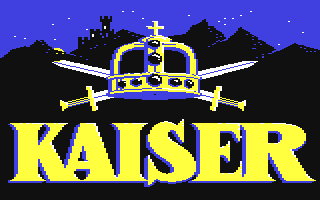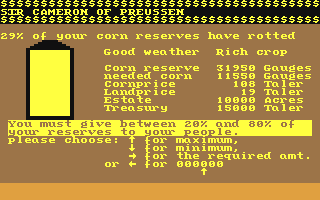|
EVERYTHING
UNDER THE SUN
If
a wargame is seen as a vehicle for the accurate simulation
of events, it needs to assimilate certain details. In
a game where artillery plays a part, rate of fire (ROF),
and burst radius have to he accurately measured if the
consequences of being caught in the beaten zone are
to be realistic. On a more general level, consider logistics.
Soldiers cannot march without food or fight without
ammunition. All these factors should be considered in
a good wargame. But, without the power of a mainframe,
there also have to be limitations.
How
likely is it that a Scorpion Recon vehicle would lose
its tracks when doing over 60mph? What would the consequences
for the commander be if he had the turret hatch open?
Such things invariably happen in large mobilisations
of forces, simply because of the probability levels,
and occasionally the consequences from these incidents
will have considerable effect. But even with a game
running over half a dozen disks, if the scale of the
wargame used company or larger sized units, such computations
would make the game unwieldy and unbearably slow to
play.
Even
in the biggest simulations, there are inaccuracies or
vague areas that would lead me to doubt their conclusions
to some extent. The Soviet armies are plagued by discipline
problems and are uncertain as to how far some of their
'allies' will support them. The NATO forces lack standardisation
in so many important areas, such as ammunition. Although
the critics are dismissive about the abilities of China's
conventional forces, how well would they fight under
pressure -- and on who's side, if anybody's?
What
happens when the terrorists get hold of the nukes?
Although
no single game could deal with all the possible situations,
a series of games could handle most of them. Fortunately,
so many wargames are brought out, the wargamer always
has a choice of scenarios to examine the effects of
certain limited possibilities. SSI, American strategists
extraordinaire, have created a series of episodic games
dealing with the subject of nuclear war in the Northern
hemisphere called When Superpowers Collide. This
month I'm going to look at part of this range. And show
you just what computer war gaming can offer. But first
. . .
.
|
|
Kaiser
involves from one to nine players competing against
fate or each other to become Emperor of 18th century
Germany. Each player begins life as a Regent, equipped
with assets and an estate which must grow and prosper
in order to bring success. The ultimate goal is to build
five towns (consisting of five markets and three grain
mills), possess at least 25000 hectares of land and
have cash assets of 100000 Talers. Lastly, a palace
and cathedral must be built. Not only names but gender
are required, as this becomes relevant to the player's
title. The game takes place in a series of phases which
combine to make a yearly turn. During the turn, all
options and responses are made via the joystick.
During
the first phase, a harvest report arrives and must be
dealt with. If the crop has been poor, then extra supplies
of grain need to be purchased unless you want the population
to die. If the harvest has been a bumper one, surplus
grain may be sold off at a profit. The option to buy
or sell land is also there for consideration. Selling
land can bring extra income (if sale prices are judged
well). Buying land is also necessary in order to build
a palace and cathedral -- both of which are required
as status symbols during the game.

The
next stage of the game is simply a status screen allowing
you to study data on birth rate, death rate, revenue
from markets and grain mills, army costs and how many
people emigrated over the past year. It is purely informative
and the game itself continues on the next screen.
This
is where you set the tax and duty rates. Displayed are
all the current levels of duty and income from each
area (such as VAT) over the previous year. These may
be changed by use of the joystick as on all the other
screens. Also, the level of justice can be altered to
increase income but this can have adverse effects, such
as emigrations by 'victims of the state'.
Play
then proceeds to another information display. A map
of your estate is drawn each year, showing how many
markets exist, how many mills are producing corn, how
far building of the palace and cathedral have progressed,
and size of the army. The map may be scrolled, rather
crudely, across the screen. The diagrammatic information
displayed on the map is clear and useful but rather
unambitious on the visual side. Again, after study,
the next stage of the game may be accessed.

With
this year's revenue displayed at the top of the screen,
there is now the option to decide how to spend it. New
mills and markets are the cheapest form of expenditure,
as they bring in an income from the next turn onwards.
On the other hand, a start could he made building the
palace (the instructions suggest the palace is built
before the cathedral). Alternatively, money could be
spent on the military. If a solo game is being played,
this area is apparently inaccessible, so you can't fight
a war with the computer. However, if a game does have
more than one player, then armies can be bought (with
the option of readily trained, but expensive, mercenaries
available), sent out on manoeuvres and of course, sent
to war with another nation. No matter how many players
are involved, an army always has to be maintained at
some level and consequently, is always a financial burden.

[This
screenshot was not in the original review]
Once
an army goes to war, a whole new game appears. Again
it is totally joystick oriented and, through a series
of prompts, forces may be deployed or put into action
-- whatever you require. Throughout a battle and at
the end of the war, details of losses are made available.
Fighting wars is definitely a costly business in terms
of manpower, but it will drastically increase the amount
of land owned, if successful.
After
military matters have been resolved, the game returns
to the first phase, one year on. However, if the turn
has been a particularly good one, a new rank in the
aristocracy will he given to you with the trapping of
extra land that comes with it. On a more sombre note,
the computer may decide you have gracefully passed away
due to old age. This is the singular major random factor
in the game. Automatically set at the start of the game,
it is the same for all players, but there is no way
of knowing when it will occur. The only thing that can
aid you to a long life is the speed at which each turn
is dealt with. The game contains a monitoring system
which calculates how quickly different matters are dealt
with and then determines your health.
|